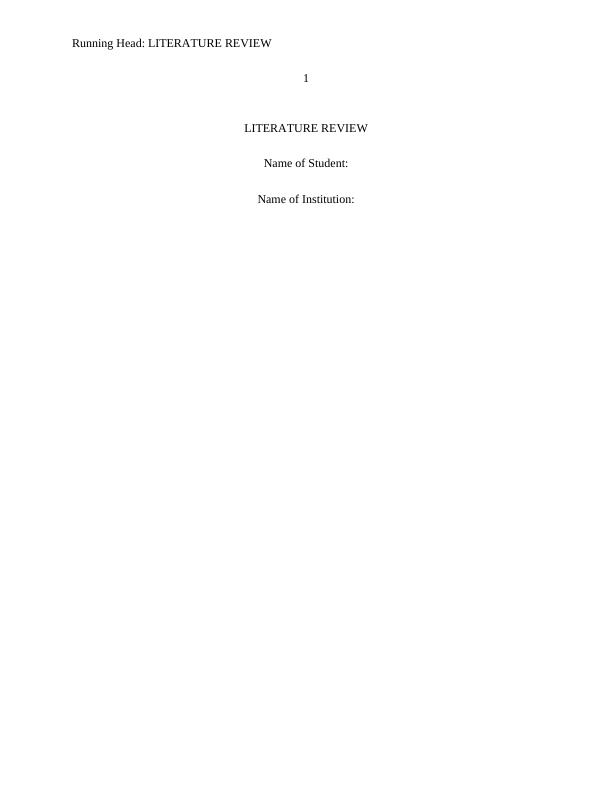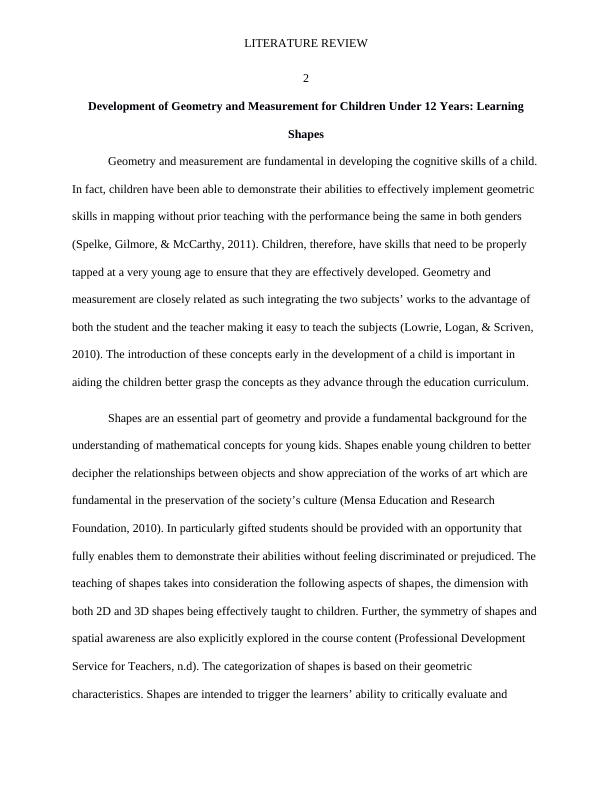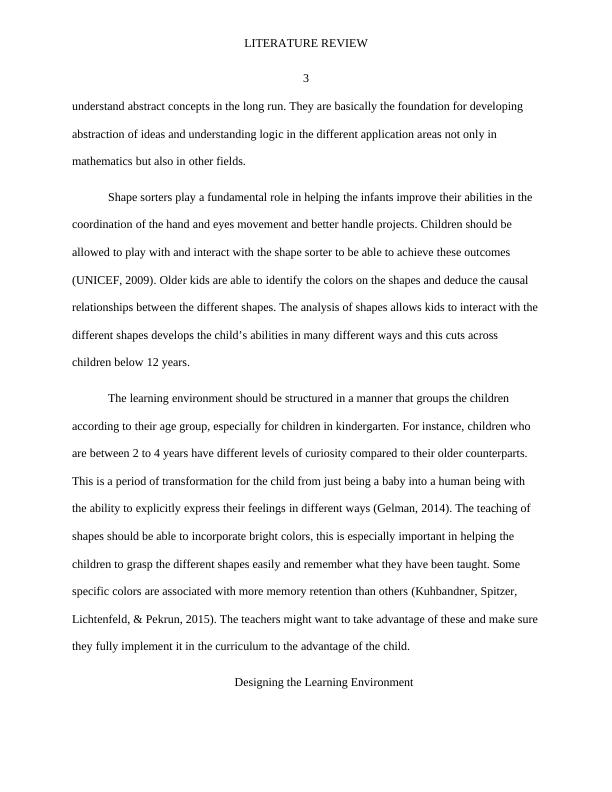Development of Geometry and Measurement for Children Under 12 Years: Learning Shapes
Added on 2022-11-26
9 Pages2342 Words452 Views
Running Head: LITERATURE REVIEW
1
LITERATURE REVIEW
Name of Student:
Name of Institution:
1
LITERATURE REVIEW
Name of Student:
Name of Institution:

LITERATURE REVIEW
2
Development of Geometry and Measurement for Children Under 12 Years: Learning
Shapes
Geometry and measurement are fundamental in developing the cognitive skills of a child.
In fact, children have been able to demonstrate their abilities to effectively implement geometric
skills in mapping without prior teaching with the performance being the same in both genders
(Spelke, Gilmore, & McCarthy, 2011). Children, therefore, have skills that need to be properly
tapped at a very young age to ensure that they are effectively developed. Geometry and
measurement are closely related as such integrating the two subjects’ works to the advantage of
both the student and the teacher making it easy to teach the subjects (Lowrie, Logan, & Scriven,
2010). The introduction of these concepts early in the development of a child is important in
aiding the children better grasp the concepts as they advance through the education curriculum.
Shapes are an essential part of geometry and provide a fundamental background for the
understanding of mathematical concepts for young kids. Shapes enable young children to better
decipher the relationships between objects and show appreciation of the works of art which are
fundamental in the preservation of the society’s culture (Mensa Education and Research
Foundation, 2010). In particularly gifted students should be provided with an opportunity that
fully enables them to demonstrate their abilities without feeling discriminated or prejudiced. The
teaching of shapes takes into consideration the following aspects of shapes, the dimension with
both 2D and 3D shapes being effectively taught to children. Further, the symmetry of shapes and
spatial awareness are also explicitly explored in the course content (Professional Development
Service for Teachers, n.d). The categorization of shapes is based on their geometric
characteristics. Shapes are intended to trigger the learners’ ability to critically evaluate and
2
Development of Geometry and Measurement for Children Under 12 Years: Learning
Shapes
Geometry and measurement are fundamental in developing the cognitive skills of a child.
In fact, children have been able to demonstrate their abilities to effectively implement geometric
skills in mapping without prior teaching with the performance being the same in both genders
(Spelke, Gilmore, & McCarthy, 2011). Children, therefore, have skills that need to be properly
tapped at a very young age to ensure that they are effectively developed. Geometry and
measurement are closely related as such integrating the two subjects’ works to the advantage of
both the student and the teacher making it easy to teach the subjects (Lowrie, Logan, & Scriven,
2010). The introduction of these concepts early in the development of a child is important in
aiding the children better grasp the concepts as they advance through the education curriculum.
Shapes are an essential part of geometry and provide a fundamental background for the
understanding of mathematical concepts for young kids. Shapes enable young children to better
decipher the relationships between objects and show appreciation of the works of art which are
fundamental in the preservation of the society’s culture (Mensa Education and Research
Foundation, 2010). In particularly gifted students should be provided with an opportunity that
fully enables them to demonstrate their abilities without feeling discriminated or prejudiced. The
teaching of shapes takes into consideration the following aspects of shapes, the dimension with
both 2D and 3D shapes being effectively taught to children. Further, the symmetry of shapes and
spatial awareness are also explicitly explored in the course content (Professional Development
Service for Teachers, n.d). The categorization of shapes is based on their geometric
characteristics. Shapes are intended to trigger the learners’ ability to critically evaluate and

LITERATURE REVIEW
3
understand abstract concepts in the long run. They are basically the foundation for developing
abstraction of ideas and understanding logic in the different application areas not only in
mathematics but also in other fields.
Shape sorters play a fundamental role in helping the infants improve their abilities in the
coordination of the hand and eyes movement and better handle projects. Children should be
allowed to play with and interact with the shape sorter to be able to achieve these outcomes
(UNICEF, 2009). Older kids are able to identify the colors on the shapes and deduce the causal
relationships between the different shapes. The analysis of shapes allows kids to interact with the
different shapes develops the child’s abilities in many different ways and this cuts across
children below 12 years.
The learning environment should be structured in a manner that groups the children
according to their age group, especially for children in kindergarten. For instance, children who
are between 2 to 4 years have different levels of curiosity compared to their older counterparts.
This is a period of transformation for the child from just being a baby into a human being with
the ability to explicitly express their feelings in different ways (Gelman, 2014). The teaching of
shapes should be able to incorporate bright colors, this is especially important in helping the
children to grasp the different shapes easily and remember what they have been taught. Some
specific colors are associated with more memory retention than others (Kuhbandner, Spitzer,
Lichtenfeld, & Pekrun, 2015). The teachers might want to take advantage of these and make sure
they fully implement it in the curriculum to the advantage of the child.
Designing the Learning Environment
3
understand abstract concepts in the long run. They are basically the foundation for developing
abstraction of ideas and understanding logic in the different application areas not only in
mathematics but also in other fields.
Shape sorters play a fundamental role in helping the infants improve their abilities in the
coordination of the hand and eyes movement and better handle projects. Children should be
allowed to play with and interact with the shape sorter to be able to achieve these outcomes
(UNICEF, 2009). Older kids are able to identify the colors on the shapes and deduce the causal
relationships between the different shapes. The analysis of shapes allows kids to interact with the
different shapes develops the child’s abilities in many different ways and this cuts across
children below 12 years.
The learning environment should be structured in a manner that groups the children
according to their age group, especially for children in kindergarten. For instance, children who
are between 2 to 4 years have different levels of curiosity compared to their older counterparts.
This is a period of transformation for the child from just being a baby into a human being with
the ability to explicitly express their feelings in different ways (Gelman, 2014). The teaching of
shapes should be able to incorporate bright colors, this is especially important in helping the
children to grasp the different shapes easily and remember what they have been taught. Some
specific colors are associated with more memory retention than others (Kuhbandner, Spitzer,
Lichtenfeld, & Pekrun, 2015). The teachers might want to take advantage of these and make sure
they fully implement it in the curriculum to the advantage of the child.
Designing the Learning Environment

End of preview
Want to access all the pages? Upload your documents or become a member.
Related Documents
Maths Reflection Writing Article 2022lg...
|3
|422
|41
Early Childhood Education: Teaching Activities for Geometry Shapes Identificationlg...
|4
|813
|266
Early Years Teaching: A Literature Reviewlg...
|11
|2620
|473
Education mathematics PDFlg...
|17
|3211
|182
Assignment on Pythagoras Theoremlg...
|21
|3725
|156
Learning Across the Early Childhood Curriculumlg...
|9
|1951
|293